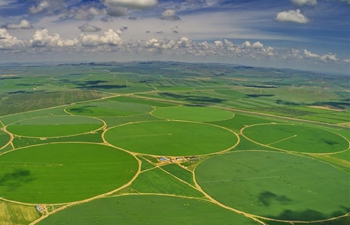LOS ANGELES, July 25 (Xinhua) -- Private U.S. spaceflight company SpaceX launched Falcon 9 rocket from California on Wednesday morning, which carried 10 more next-generation satellites for Iridium Communications, and successfully landed the first stage on a drone ship in the harshest weather conditions to date.
After the rocket's nine Merlin 1D engines passed an automated health check, the Falcon 9 was released from the Space Launch Complex 4E (SLC-4E) at Vandenberg Air Force Base at 4:39 a.m. PDT (1139 GMT).
Because of the precision needed for satellite insertion, the launch had only a one-second window, John Insprucker, a principal integration engineer at SpaceX, said during a live webcast.
The launch went smoothly, despite the fact that fog obscured the view of the rocket until after lift-off.
At about two minutes and 27 seconds, the company confirmed main engine cutoff and stage separation.
The weather and sea conditions were "fairly rough. They are the worst that we've ever had for trying to get a first stage on the drone ship," said Insprucker during the live webcast.
Following the launch, SpaceX expected to recover as much of the rocket as it possibly could.
About seven minutes and 17 seconds later, the rocket's first stage successfully landed on the drone ship "Just Read the Instructions" stationed in the Pacific Ocean.
"Despite challenging weather conditions, Falcon 9 first stage booster landed on Just Read the Instructions," SpaceX tweeted.
The launch also included an attempt to catch the Falcon 9's nose cone, or payload fairing, with a giant net stretched across a boat called Mr. Steven. However, the weather was too harsh for the maneuver, the company confirmed in a later update.
"They did see the payload fairing coming down, but they were not able to catch it in the net," Insprucker said during the broadcast about 50 minutes after liftoff.
SpaceX has been trying to catch its rockets' fairings for months, but the California-based company hasn't been able to catch one out of the sky yet. Earlier in July, the company tweeted photos of a boat with an upgraded net four times larger than the previous version.
The primary mission of Wednesday's launch, called Iridium-7, is to deliver 10 satellites to low-Earth orbit for Iridium Communications, an American company providing satellite communications.
The Iridium Next satellites were deployed about 56 minutes after liftoff, with the process taking about 15 minutes.
"Successful deployment of 10 @IridiumComm NEXT satellites to low-Earth orbit confirmed," SpaceX tweeted.
The mission has brought the total number of Iridium's satellites in orbit to 65. It is the seventh of eight scheduled SpaceX launches for Iridium's next-generation global satellite constellation, Iridium NEXT.
In total, 81 satellites are built, with 66 in the operational constellation, nine serving as on-orbit spares and six as ground spares.
Iridium is the only mobile voice and data satellite communications network that spans the entire globe. The company said it is on track to fully replace the world's largest commercial satellite network of low-Earth orbit satellites in what will be one of the largest "tech upgrades" in history.
The next generation global satellite constellation will provide coverage over Earth's entire surface, including across oceans, airways and polar regions, according to the company.
Wednesday's launch followed a launch from the opposite coast on Sunday and will be followed by another launch scheduled for early August.


















